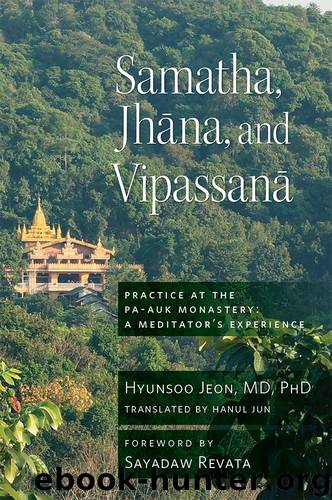Samatha, Jhana, and Vipassana by Hyun-Soo Jeon

Author:Hyun-Soo Jeon
Language: eng
Format: epub
Publisher: Wisdom Publications
THE FIVE-DOOR COGNITIVE PROCESS
After becoming skilled at discerning the wholesome sense-sphere consciousnesses that form after practicing samatha and the wholesome sense-sphere consciousnesses that arise in daily life, we discern the five-door cognitive process, as well as the mind-door process that follows the five-door cognitive process. The five-door cognitive process is a cognitive process that arises by taking visible form, sound, smell, taste, and touch as objects from the eye, ear, nose, tongue, and body. The five-door cognitive process is usually followed by the mind-door process, but if the impact of the object on the respective sensitivities is weak, even the five-door cognitive process may not arise fully. In that case, the mind-door cognitive process does not arise.
First we will look at the eye-door cognitive process that arises taking visible form as object.
This process consists of mind moments of eye-door adverting, eye consciousness, receiving, investigation, determining, javana, and possibly registration.
Eye-door adverting arises when visible form impinges on eye sensitivity and attention goes to that object in order to see it. We don’t necessarily have to see phenomena with our eyes open for the eye-door cognitive process to start. The eye-door cognitive process arises even if we pay attention to the color of the kalāpas nearby with our eyes closed. However, eye-door adverting doesn’t arise just because a visible form impinges on eye sensitivity. We need to have the attention to see the visible form in order for eye-door adverting to arise. Once, when meditating, I was surprised when I experienced that the eye-door cognitive process didn’t arise when I first looked at a tree, but rather it began when I turned my attention to see the tree. This attention is eye-door adverting. There are eleven consciousness + mental factors present in eye-door adverting: consciousness, contact, feeling, perception, volition, one-pointedness, life faculty, attention, initial application, sustained application, and decision. When there is eye-door adverting, the consciousness + mental factors operate on an object of visible form, but each performs its own functions.
Next eye-door adverting disappears and eye consciousness arises. There are eight consciousness + mental factors of eye consciousness: consciousness and the seven universals. When eye consciousness disappears, receiving arises. Receiving is the moment when the sensory object (in this case, visible form) is received by the sense door (in this case, the eye door). There are eleven consciousness + mental factors of receiving, the same as the consciousness + mental factors of eye-door adverting. When receiving disappears, investigation arises. Investigation is the moment when consciousness examines the sensory object (in this case, visible form). There are twelve consciousness + mental factors of investigation if the object is desirable and joy is present, and there are eleven if there is equanimity without joy. When investigation disappears, determining arises. Determining is the moment when the sense object (in this case, visible form) is identified by consciousness. There are twelve consciousness + mental factors of determining. Aside from the investigation mind moment, the rest (eye-door adverting, eye consciousness, receiving, and determining) are all mind
Download
This site does not store any files on its server. We only index and link to content provided by other sites. Please contact the content providers to delete copyright contents if any and email us, we'll remove relevant links or contents immediately.
The Way of Zen by Alan W. Watts(6292)
Ego Is the Enemy by Ryan Holiday(4963)
The Art of Happiness by The Dalai Lama(3851)
The Book of Joy by Dalai Lama(3704)
Why Buddhism is True by Robert Wright(3290)
Spark Joy by Marie Kondo(3089)
Shift into Freedom by Loch Kelly(3031)
Happiness by Matthieu Ricard(2888)
A Monk's Guide to a Clean House and Mind by Shoukei Matsumoto(2786)
The Lost Art of Good Conversation by Sakyong Mipham(2443)
The Meaning of the Library by unknow(2390)
The Third Eye by T. Lobsang Rampa(2174)
The Unfettered Mind: Writings from a Zen Master to a Master Swordsman by Takuan Soho(2160)
Red Shambhala by Andrei Znamenski(2073)
Anthology by T J(2047)
The Diamond Cutter by Geshe Michael Roach(1957)
Thoughts Without A Thinker: Psychotherapy from a Buddhist Perspective by Epstein Mark(1899)
Advice Not Given by Mark Epstein(1766)
Twilight of Idols and Anti-Christ by Friedrich Nietzsche(1764)
